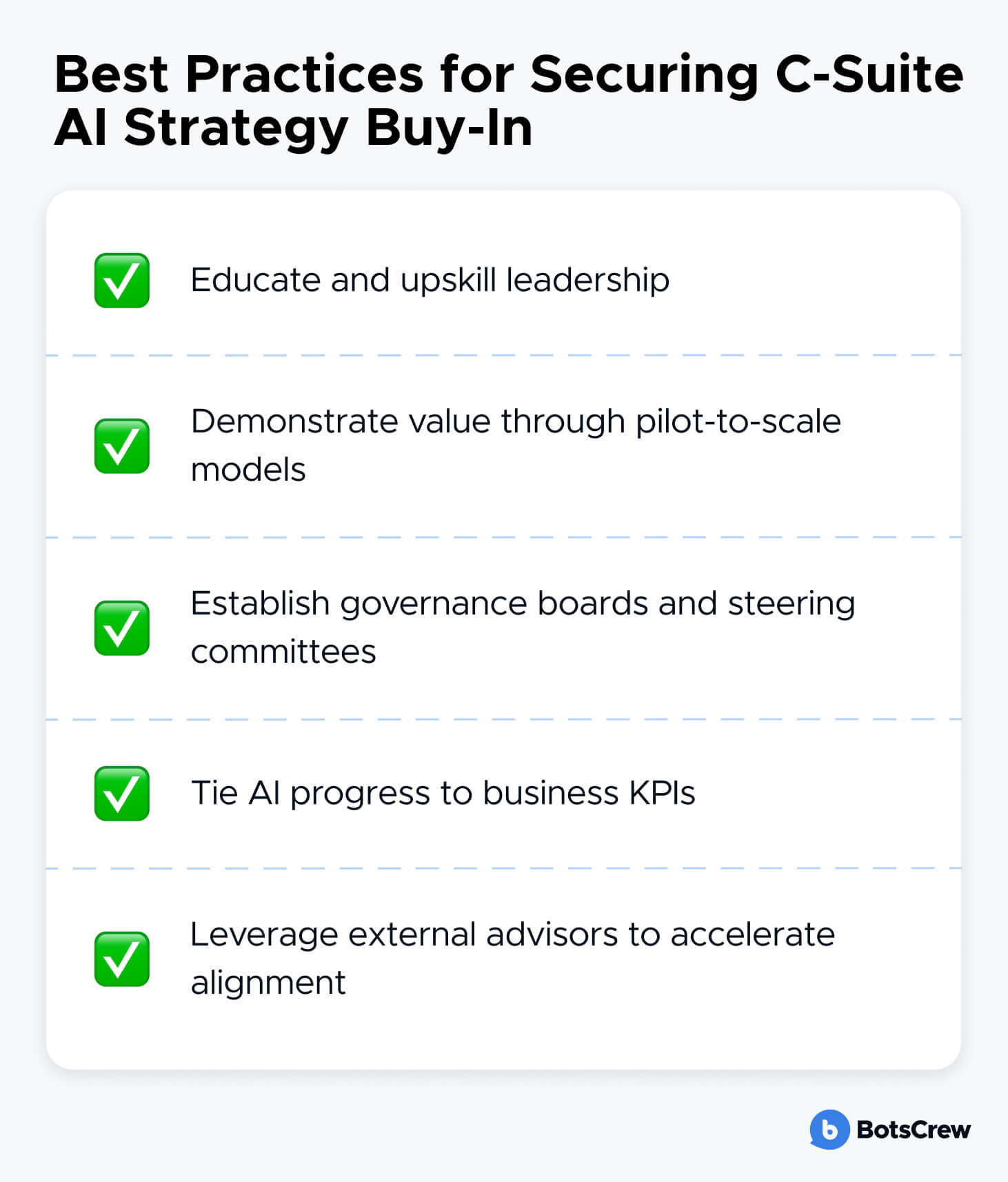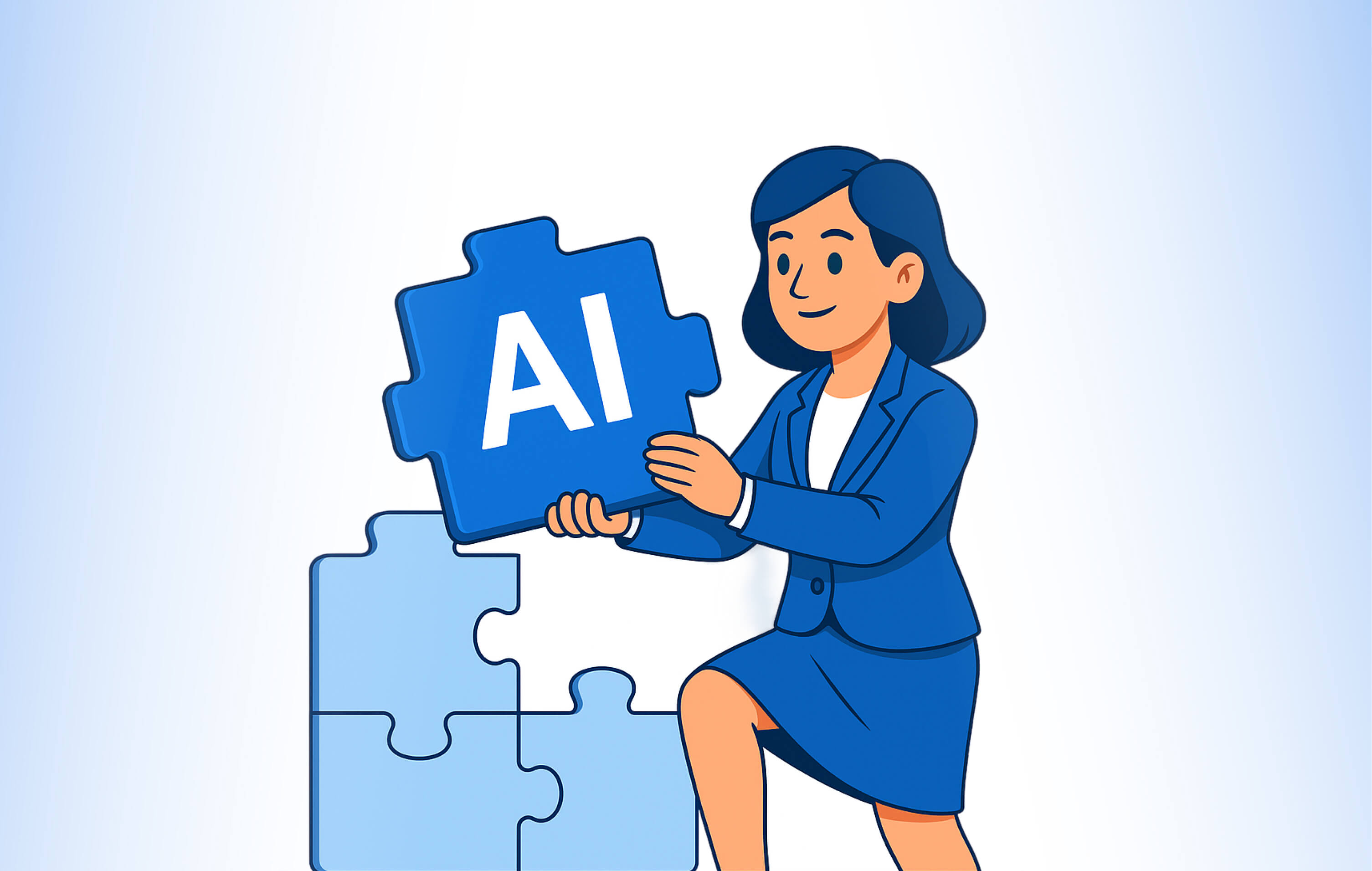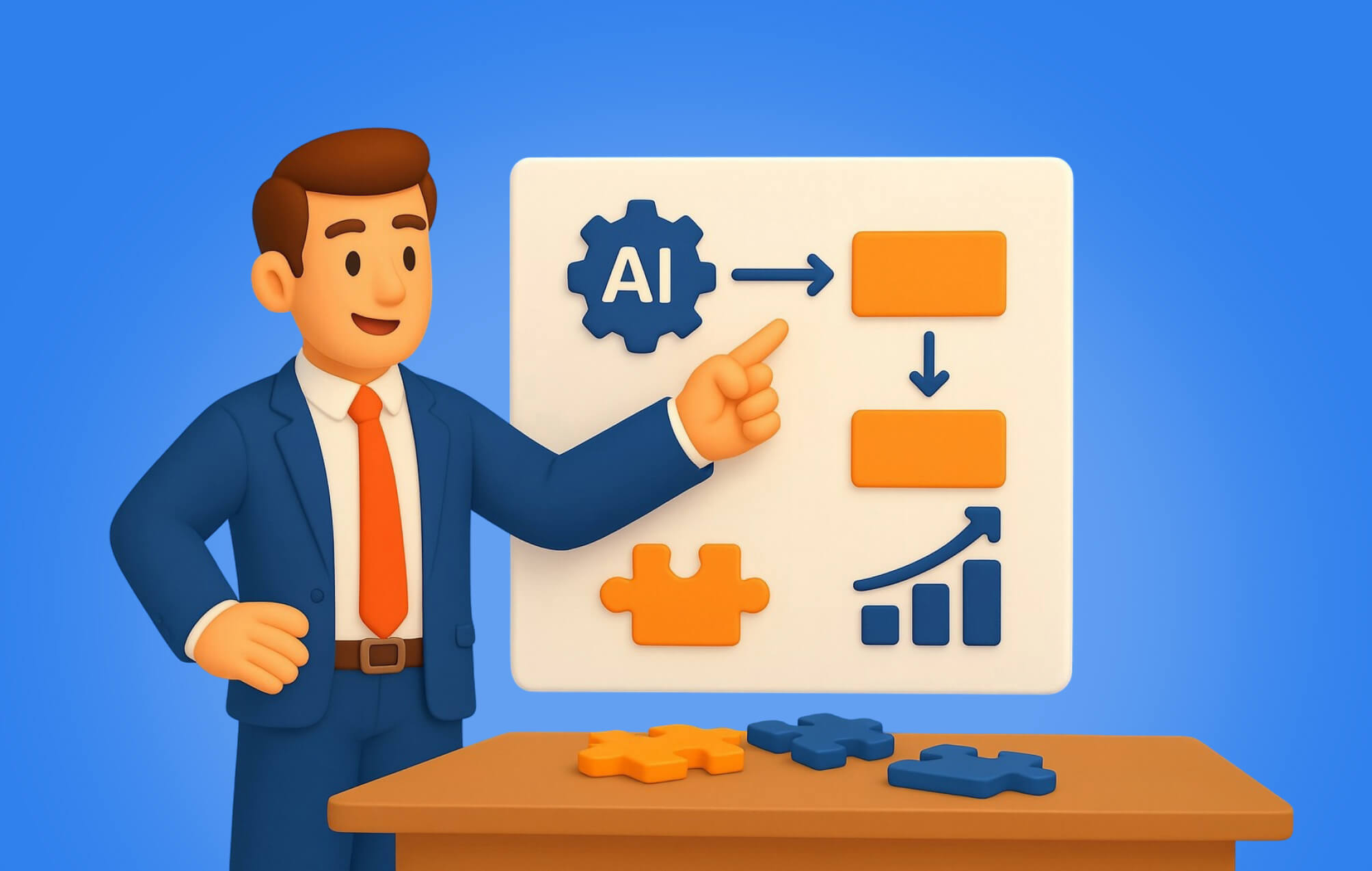Executive Buy-In and the Role of Leadership in AI Adoption
The role of leadership in AI adoption is critical. Most AI pilots stall not because of technology, but due to weak executive sponsorship. With committed C-suite leadership, AI moves beyond experiments to deliver enterprise-wide growth, efficiency, and transformation.

Artificial intelligence is no longer a futuristic vision — it’s a competitive necessity. Enterprises are investing heavily in AI pilots, yet the majority fail to deliver measurable impact at scale. The culprit isn’t usually the technology itself, but the absence of committed leadership.
of respondents said their organization has moved 30% or fewer of their Generative AI experiments into production.
According to McKinsey, companies with active CEO involvement in AI governance significantly outperform their peers. Still, only 28% of organizations report CEO-level oversight of AI initiatives. This gap explains why so many AI projects stall: without visible, strategic leadership, AI remains an experiment rather than an enterprise-wide driver of growth.
Curious how your leadership team stacks up? Take our AI Readiness Assessment to see if your enterprise is prepared for large-scale adoption.
The truth is clear: AI adoption is not just a technical challenge; it’s a leadership challenge. Successful AI initiatives require vision, accountability, and cultural alignment — all of which begin at the top.
At BotsCrew, we’ve seen this pattern repeat across industries. Enterprises with strong C-suite sponsorship scale AI faster, achieve higher ROI, and integrate solutions more effectively into real workflows. Those without executive buy-in struggle to move past pilots. That’s why understanding the role of leadership in AI adoption — and building a C-suite AI strategy — is essential for success.

The Role of Leadership in AI Adoption
When it comes to AI, leadership is more than sponsorship — it’s ownership. Executives set the tone for how AI is perceived and adopted across the enterprise. Without their guidance, even the most innovative use cases can get stuck in silos or fail to scale.
of executives from organizations with C-level sponsorship report seeing ROI now on at least one gen AI use case
From vision to execution
Successful AI adoption begins at the top. Executives who articulate a clear AI vision tied to business outcomes—whether revenue growth, operational efficiency, or customer experience—set the stage for enterprise-wide alignment. Instead of framing AI as a technical add-on, strong leaders embed it directly into corporate strategy.
of respondents attributed AI adoption failure to insufficient executive sponsorship
Without leadership framing AI as a business-critical initiative, projects tend to remain fragmented, driven by individual departments without alignment to enterprise goals. This lack of clarity often leads to wasted resources and failed pilots.
How leaders do it: By setting a clear AI vision at the top, executives can define measurable objectives tied to growth or efficiency, integrate them into corporate strategy, and communicate that narrative consistently. For example, a CEO announcing AI as central to the company’s customer-first mission can shift perception from “IT experiment” to “enterprise imperative.”
Need help aligning AI with your enterprise strategy? Book a free consultation call with our AI Strategy Advisors.
Shaping culture and mindset
Resistance to change is one of the biggest barriers to AI adoption. C-suite leaders have the influence to foster an environment where teams see AI as a partner, not a threat. By championing AI openly, executives normalize its role in daily operations and encourage a culture of experimentation.
of employees fear AI causing permanent job loss
Employees often fear automation will replace them or distrust tools they don’t understand. Without leadership reassurance, these fears can slow or even block adoption. Culture, not technology, becomes the bottleneck.
How leaders do it: Executives can position AI as an enabler of human productivity, emphasize reskilling and upskilling, and highlight success stories where AI supported, not replaced employees. Publicly celebrating AI-driven wins also helps create momentum and reduces skepticism.
Embedding AI into decision-making
AI delivers impact when it’s integrated into workflows, KPIs, and governance structures.
Leadership plays a crucial role in ensuring AI doesn’t remain a “side project” owned by IT or data teams but becomes part of how the organization makes decisions and serves customers.
of AI-leading companies achieve strong alignment between AI initiatives and business goals, compared to 17% of those still experimenting
When AI sits in silos, its benefits are limited to isolated use cases. Without leadership-driven integration into performance metrics and governance, adoption rarely scales.
How leaders do it: Executives can mandate that AI outcomes be tied to core KPIs, establish governance boards to oversee adoption, and require business units to report on AI-driven results. This creates accountability and ensures AI informs enterprise-wide decision-making rather than staying trapped in departmental pilots.
Removing Barriers and Building Trust
Despite enthusiasm, many executives hesitate due to uncertainty around ROI, data privacy, and regulatory compliance. Transparent leadership is key to overcoming these barriers. Clear communication about risk management, ethical AI principles, and expected returns builds organizational trust.
According to McKinsey, companies that address governance and ethics upfront are 2.6x more likely to succeed in scaling AI. Leaders who invest in cross-functional collaboration—bringing together data science, compliance, and business strategy—create the conditions for sustainable adoption.
Executives who report their organization has comprehensive executive alignment are consistently more likely to see a tangible ROI from their AI initiatives (Google)

In short, the role of leadership in AI adoption is not optional — it’s foundational. Executive buy-in determines whether AI becomes an isolated experiment or a scalable business transformation.
Barriers to Executive Buy-In
If executive commitment is so critical to successful AI adoption, why do so many enterprises lack it? The reality is that even the most visionary leaders face barriers that make AI adoption a daunting proposition. These challenges often explain why enthusiasm for AI at the grassroots level does not translate into decisive action at the top.
The AI literacy gap is one of the biggest hurdles. Many senior leaders are highly skilled in finance, operations, or corporate strategy but have limited understanding of AI’s capabilities and limitations. Without clarity, they may view AI as either overhyped or incomprehensible, leading to indecision. This lack of literacy also makes it harder for executives to distinguish between realistic opportunities and inflated promises, leaving them hesitant to commit resources.
of leaders identify skill gaps in their workforces as a significant barrier to AI adoption
Another barrier is misalignment between technical and business priorities. Data science teams often focus on cutting-edge models or proof-of-concept projects, while executives are under pressure to deliver revenue growth, efficiency gains, or risk reduction. Without a common language, AI initiatives can feel disconnected from strategic objectives. Leaders, in turn, may see them as cost centers rather than growth drivers, undermining support for scaling.
Risk aversion also plays a role. Executives are keenly aware that AI introduces compliance, ethical, and reputational risks. Concerns about biased algorithms, regulatory scrutiny, or data privacy breaches make leaders cautious. For boards tasked with safeguarding shareholder trust, it is often easier to slow down or defer AI adoption than to push forward without robust safeguards.
of CEOs are concerned about data security and 48% worry about bias or data accuracy
Finally, cultural inertia can’t be overlooked. Middle management, often tasked with implementing AI, may resist changes that threaten established processes or roles. Without visible executive sponsorship to overcome this inertia, AI initiatives struggle to gain traction. Leaders may hesitate to push too hard, fearing internal pushback or morale issues, and as a result, adoption stalls.
These barriers explain why executive buy-in is not automatic, even when the benefits of AI seem obvious. Overcoming them requires deliberate effort: building literacy, aligning priorities, managing risks proactively, and fostering a culture that embraces change. Without addressing these challenges head-on, even the best-designed AI strategies risk running into resistance at the very top.
Facing resistance at the top? Book a free consultation with our AI Strategy Advisors — we’ll help you build the case for executive buy-in and design a path to scale.
Best Practices for Securing C-Suite AI Strategy Buy-In
Securing executive buy-in isn’t a one-time announcement — it’s an ongoing process of building understanding, confidence, and alignment across the leadership team. The most successful enterprises treat AI not as a project but as a strategic capability, and they follow a consistent playbook to get there.
Educate and upskill leadership
AI literacy is foundational. Executives don’t need to understand neural networks, but they do need to grasp what AI can and cannot do, where risks lie, and how it drives value. Companies that invest in executive workshops, training sessions, and peer-to-peer learning see far stronger alignment at the top. For example, boards that regularly review AI use cases alongside financial results are better positioned to make informed decisions about scaling.
Unilever is investing in both people and culture through a programme that has trained more than 20,000 people in GenAI use.

KPMG – Building AI Fluency with GenAI 101
KPMG is strengthening workforce readiness through its GenAI 101 program, designed to equip employees with foundational AI knowledge. The training introduces participants to essential terminology, practical workplace applications, and the ethical considerations of AI use. It also covers the mechanics of crafting effective AI prompts—helping employees not just understand AI, but apply it in day-to-day tasks responsibly.
PwC – Gamifying AI Training with PowerUp
PwC takes a more interactive approach with PowerUp, a gamified curriculum aimed at boosting AI literacy across the organization. Through a live monthly trivia game, employees test their knowledge of firm strategy and AI concepts, earning prizes while learning. The program has become a cultural touchpoint—drawing more than 9,000 participants each month across the U.S. and Mexico, fostering both engagement and collaboration around AI adoption.
Demonstrate value through pilot-to-scale models
Leaders are far more likely to commit when they see results. Starting with targeted pilots that address real business problems and deliver measurable ROI is the fastest way to build confidence. The key is not to stop at pilots but to create a repeatable framework for scaling successful projects enterprise-wide. Demonstrating how a chatbot reduces support costs or how predictive analytics improves forecasting helps shift conversations from “if” to “where next.”
Establish governance boards and steering committees
AI requires oversight at the highest level. Formal governance bodies signal that adoption is not experimental but strategic. These boards bring together executives from across functions — technology, finance, operations, HR — to align priorities, manage risks, and monitor outcomes. This structure reduces duplication, increases accountability, and keeps adoption tied to enterprise goals.
Tie AI progress to business KPIs
Executives will only treat AI as a priority if its impact is visible in core metrics. Integrating AI-driven outcomes into quarterly reports, performance dashboards, or board reviews makes adoption tangible. For instance, reporting that “AI reduced customer churn by 5%” or “AI-driven claims processing cut operational costs by $12M” ensures leadership sees AI as a lever for business performance, not a side project.
Leverage external advisors to accelerate alignment
Just 29% of executive teams agree they have the in-house expertise to adopt generative AI (IBM). Sometimes executives hesitate because they lack clarity or confidence. In these cases, external advisors — AI consultants, industry partners, or peer networks — can help bridge the gap. Advisors provide perspective on what’s realistic, offer benchmarks from other industries, and help design strategies that balance ambition with feasibility. This outside-in perspective often accelerates buy-in by validating decisions and reducing uncertainty.
Purchasing AI tools from specialized vendors and building partnerships succeed about 67% of the time, while internal builds succeed only one-third as often (MIT/Fortune)
Enterprises that follow this playbook move from fragmented, cautious pilots to coordinated, confident AI adoption. More importantly, they build leadership teams that are aligned not just around the “why” of AI, but around the “how” — ensuring the entire C-suite moves forward together.

Conclusion: AI Success is a Leadership Imperative
AI adoption is no longer a question of if — it’s a question of how quickly and how effectively enterprises can scale it. The research is clear: technology alone doesn’t determine success. The decisive factor is leadership. Companies where the C-suite takes ownership of AI — setting vision, building governance, aligning investment, and preparing the workforce — are the ones that turn pilots into profit and experiments into transformation.
The role of leadership in AI adoption cannot be overstated. Without executive buy-in, AI remains fragmented, experimental, and disconnected from business outcomes. With it, AI becomes a force multiplier, enabling enterprises to drive growth, efficiency, and resilience at scale.
For organizations ready to take AI seriously, this is not just a technical journey — it’s a leadership journey. Executives must move from passive supporters to active owners of AI strategy, guiding adoption from the top down and embedding it into the DNA of the business.
At BotsCrew, we help leadership teams make this transition. Through our AI Readiness Assessments, Discovery Sprints, and Strategy Roadmaps, we work directly with the C-suite to bridge the gap between ambition and execution. Our goal is to help enterprises move past pilots and build scalable AI capabilities that deliver measurable business value.
AI will shape the winners and laggards of the next decade. The question for executives is simple: will your leadership unlock its potential — or hold it back?
Ready to lead your enterprise into the AI era? Let’s talk.








